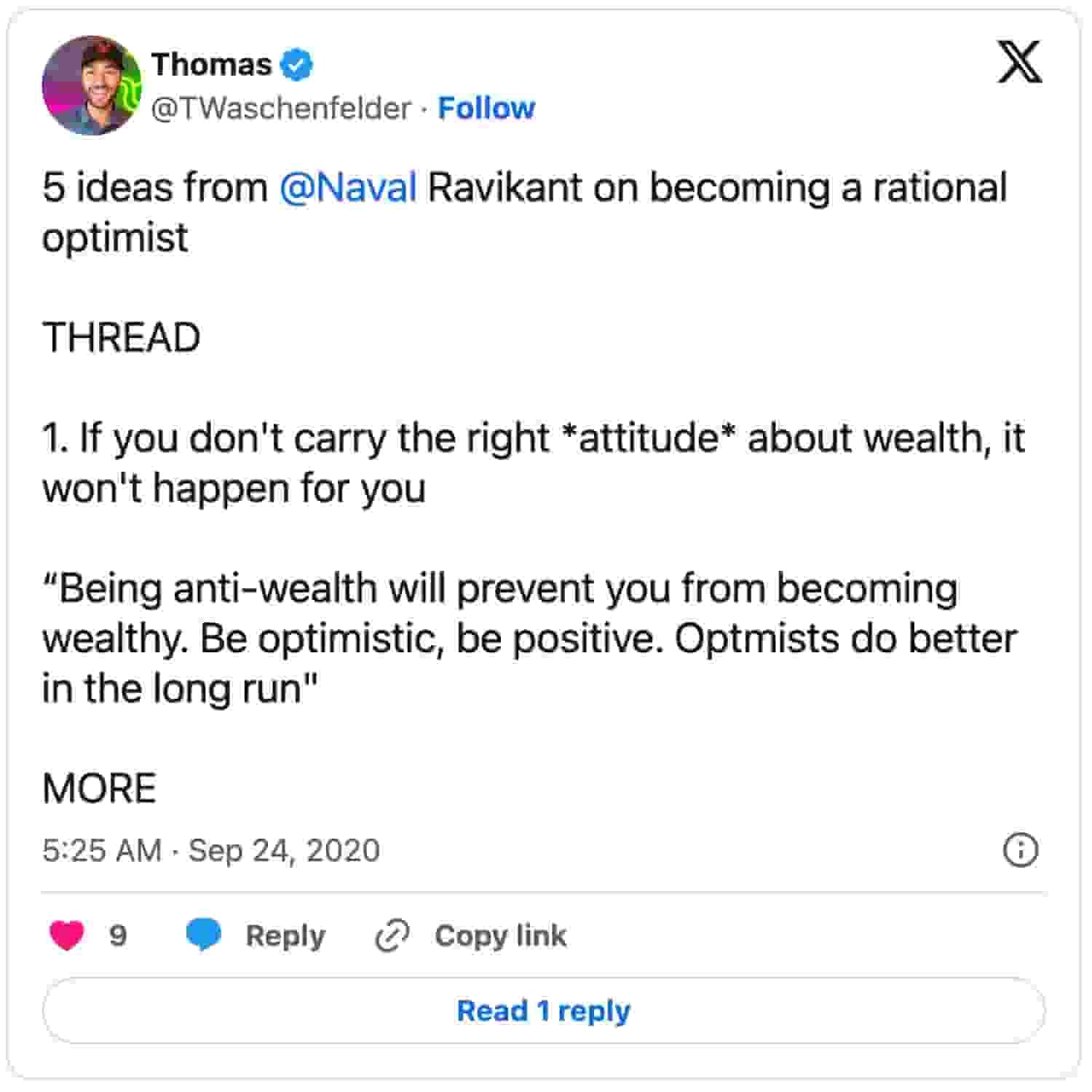Here’s Why You Should Become A Rational Optimist
To build wealth, you need to believe you are capable of doing it.
This belief isn’t trivial. Only those who are convinced they can create wealth for themselves and their family will do it. You need the right mindset for the long haul. If you think wealth creation is inherently evil, it will evade you.
Naval Ravikant has a useful model for this: rational optimism.
If you want to create wealth, it will be easier if you become a rational optimist.
Rational Optimists Create More Stuff.
If you are rational, you see the world as it is, not how you want it to be.
If you are optimistic, you’re bringing confidence to your work and are optimistic about your capability to create.
Here’s Naval breaking out these terms:
To create things, you have to be a rational optimist. Rational in the sense that you have to see the world for what it really is. And yet you have to be optimistic about your own capabilities, and your capability to get things done.
It takes a ton of work to become rational.
I’ve written a lot about mental biases and how difficult it is to see the world as it really is.
The two most important models for seeing the world clearly are reciprocation tendency and the power of incentives. Start with these, and you’ll be on your way.
Optimism takes work too.
Naval explains that back when humans were hunters and gatherers on the open plains, it was the pessimist who survived. If a pessimist heard something big rustling in the bushes, they’d run because they assumed it was a lion or another deadly predator.
If an optimist heard something big rustling in the bushes, they’d assume it was nothing to worry about and continue foraging.
Eventually, the optimist would get eaten, while the pessimist survived.
Today, the world is far less dangerous. The chances of getting killed by the natural world are relatively low. But our minds are still the same. Because we are descendants of pessimists, our default setting is hyper-vigilant anxiety.
So, it takes work to become an optimist. But it’s possible (more on that later).
Rational Optimists Make Asymmetric Bets
Asymmetric bets are ones where the upside is unlimited, while the downside is capped.
Pessimists often overanalyze the downside. They convince themselves the risk is too high on all opportunities and usually end up doing nothing.
Rational optimists analyze the downside and assess whether they will avoid ruin if it fails. The definition of ruin depends on the circumstance. If it’s something like sky diving, then ruin could mean death. If it’s a financial bet, it could mean bankruptcy.
The goal is to seek opportunities where you’ll survive even if it doesn’t work out, but you could win BIG if the opportunity does pay off.
Here’s what Naval says about making bets:
Stay out of things that could cause you to lose all of your capital, all of your savings. Don’t gamble everything on one go. Instead, take rationally optimistic bets with big upsides.
Remember, the downside in a first world country is relatively small. Even bankruptcy can be endured and recovered from. Smart, pessimistic people, talk themselves out of all sorts of opportunities because they fear a downside that doesn’t exist. Becoming a rational optimist solves this.
Rational Optimists Have A Bias Towards Action.
Rational optimists do stuff. Then, they learn from trial and error and take the path that has the most promise.
Here’s Naval again:
All the really successful people I know have a very strong action bias. They just do things. The easiest way to figure out if something is viable or not is by doing it. At least do the first step, and the second step, and the third, and then decide.
This leads to iteration – doing the same thing repeatedly with slight variations to find out what works best.
For example, there have been countless iterations of this blog. I’ve changed the home page, newsletter page, and article page many times to find the right messaging. It will continue to change as I experiment.
Action leads to iteration, which gives you a great chance of finding something that works.
You Can Become A Rational Optimist, Even If You’re A Pessimist Now.
You can rewire your brain to become an optimist.
This is what Naval did. He uses self-awareness to interrupt the flow of negative thoughts. Then, he actively replaces those thoughts with something positive. After a little while of doing this, it becomes second nature.
Here’s Naval in his own words:
If I catch myself judging somebody, I can stop myself and say, “What’s the positive interpretation of this?” I used to get annoyed about things. Now I always look for the positive side of it. It used to take a rational effort. It used to take a few seconds for me to come up with a positive. Now I can do it sub-second.
Meditation can help you do this.
I am a pessimist by default (and a very annoying one, at that – just ask my wife!). But I use meditation to notice this negative bias, let it go, and then replace it with something positive. It doesn’t come naturally to me, but I’m getting better.
You can also make optimism your default setting by taking care of yourself. Get enough sleep, expose yourself to sunlight, exercise, eat real food, and avoid cheap dopamine (drugs and alcohol). All of this will help prime your mind for optimism.
Surround Yourself With Other Rational Optimists.
My wife is the most optimistic person I’ve ever met. This makes it far easier for me to become a rational optimist than if I would have married another pessimist.
You’ve probably heard the saying that you are the average of the five people you hang around the most. Choose optimists - not ones who are unrealistically optimistic. Remember, rationality means you see the world as it is, not how you want it to be. Choose ones who ground their optimism in reality. Over time, you’ll naturally soak up their positivity until it’s a part of you.
Be patient, though. If you’re like me, you have 25+ years of conscious negativity. It takes time to rewire those neurons.
Here’s Naval on the importance of carefully choosing who you surround yourself with:
You should choose your friends very wisely. You shouldn’t choose them haphazardly based on who you live next to or who you happen to work with. The people who are the most happy and optimistic choose the right five [people].
One of the best hacks to make self-improvement a default setting is to surround yourself with people far better than you. This includes the content you consume, the books you read, and the videos you watch.
All of these impacts your point of view and influence whether you think like an optimist or a pessimist.
Rational Optimists Can Be Positive And Honest At The Same Time.
Rational optimism isn’t about ignoring the truth. It’s about looking for the positives in reality. In that way, you can learn to be honest and kind at the same time.
If you find a way to tell the truth while respecting the integrity of the other person, you usually make yourself a friend and a partner.
Some people will get insulted by the truth no matter how you deliver it. Distance yourself from those people as soon as possible. They will only bring you pain.
Naval writes:
Charisma is the ability to project confidence and love at the same time. It’s almost always possible to be honest and positive.
It’s hard to become a rational optimist. I know because I’m a recovering pessimist who is trying to change how my brain is hardwired.
But, if you:
Eat well
Exercise
Meditate
Get sunlight
Get enough sleep
Make asymmetric bets
Practice positive thinking
Surround yourself with positive optimists
You are well on your way.
Keep going.
Signed,
A Recovering Pessimist.
If You Want More Ideas Like This, Follow Me On Twitter And Subscribe To My Newsletter:
Sources:
Naval Ravikant: How To Get Rich (Every Episode)
Jorgenson, Eric. The Almanack of Naval Ravikant: A Guide to Wealth and Happiness (p. 67). Magrathea Publishing. Kindle Edition.






